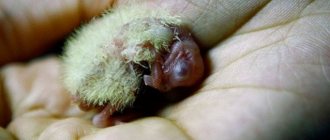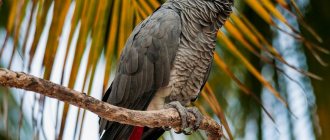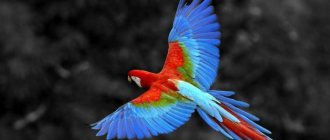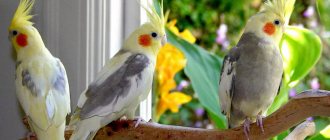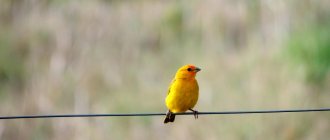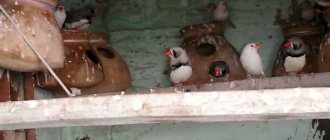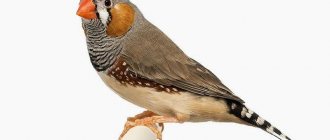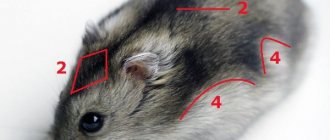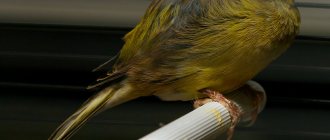Appearance, dimensions
Latin name: Nymphicus hollandicus. The dimensions of the cockatiel are body length including the tail 29-33 cm, half of which is the tail. The average weight of an adult is about 100 grams, although both heavier and lighter ones can be found. Natural color - predominantly gray plumage, yellow face, orange cheeks, yellow-gray crest. In addition to the described color, breeders have developed many other variations. The colors of cockatiels are: regular (or natural), lutino, pearl, albino with red or black eyes, pearl lutino, light gray, cinnamon, motley, white-headed, dark yellow and other variations.
Three ways to determine the sex of a cockatiel. One of the ways is in a squeaking pose: males slightly spread their feathers, their tail is horizontal to the body, and their head is directed downward, while females raise their tail a little up and, unlike males, do not lower their head down, but, on the contrary, throw it on their back. Secondly, in males of natural color, as they grow older, the face begins to turn yellow (in the female, the face remains pale gray with a yellow tint, like in chicks), and the color of males is more juicy. For other colors, this method (determination by yellow face) cannot be used. The third way to determine sex is DNA analysis.
The average lifespan of cockatiels is about 15 years. There are also long-livers. For example, the International Zoo Yearbook provides information about an individual who lived 35 years.
CORELLA BREEDING
The breeding season occurs in the north in April - July, in the south in August - September. For nesting they choose cavities or hollows in old trees. The bottom is covered with chewed shavings, deepening the nesting chamber to the desired size. The female lays 3 - 7 oblong eggs. It is noteworthy that both partners incubate the clutch, alternately replacing each other. Sometimes they can split the number of eggs and incubate them at the same time. The eggs are incubated for about 21 days. The chicks leave the nest when they are weeks old.
Keeping at home
They can be characterized as follows: they are sociable, friendly, quickly tamed, they can get along with other birds, but they are capable of producing a sharp and shrill sound, which will be a problem for particularly sensitive owners. At the same time, this type of bird is the second most popular after budgerigars, which quite clearly shows the superiority of the pluses over the minuses.
Care and maintenance of a cockatiel includes: selection of a high-quality cage, its arrangement and preparation of a diet. In addition, this is necessary: daily cleaning of the cage, replacement of food, bathing and, of course, communication with the pet. Being social creatures, accustomed to living indoors, they need communication. Such communication can be: learning tricks, commands, conversation, and even the participation of birds in your household chores.
Temperament and behavior
Cockatiels are cute parrots that are well suited for those new to bird keeping. They are very easy-going, friendly and get along well with both people and other birds. In the wild they live in small flocks of about 12 individuals, however they can gather in large flocks of 100 individuals after the mating season or in areas where food is plentiful.
Cockatiels love a lot of attention and human touch. They can form strong bonds with their owners. Cockatiels are very social and love to spend a lot of time with their human flock. With the right approach, they are easy to care for and can become excellent companions.
How to choose a cage?
The cage is the place where the bird will spend a significant part of its time. You need to choose a lattice house that is as large as possible so that the parrot has enough space to move and play. The minimum dimensions are: length - 50 cm, width - 40 cm, height - 70 cm. The distance between the rods should not exceed 2 cm. It is undesirable to choose models that are round in shape or have curved parts that can cause injury. It is best to place the cage itself on a special stand or on a cabinet. It is optimal when one side is adjacent to the wall. It is not recommended to place it near radiators, in the kitchen, near household appliances, in direct sunlight or in a draft.
The material “Cage for a Corella Parrot” discusses in more detail the issues of choosing lattice apartments, and also examines popular models, gives their photographs and main characteristics.
Among the accessories inside the bird house, you need to place: 2-3 feeders, a drinking bowl, perches, toys and accessories for active games, for example, ladders, swings, rings or ropes. The drinking bowl and feeders must be positioned in such a way that droppings do not fall into them. The number of perches depends on the size of the home; usually there should be at least 2-3 pieces. The basic perches should be branches with bark with a diameter of 2-2.5 cm. Additional perches can be rope, mineral, modeled and other variations of perches. Particular attention should be paid to toys that will help your pet not get bored during the day. In the material “Toys for Cockatiels” you can see photographs of some of the possible fun.
Cockatiel Contents
You will need to purchase a spacious cage.
Cockatiels love spacious cages. The cage must be wide enough for the parrot to freely spread its wings in it, at least 45x45x60 cm. It is important that the cage is constructed of strong metal, otherwise they will easily destroy the wooden cage. Cages with horizontal bars work well as these birds love to climb and climb. The bottom of the cage can be covered with paper, sand or gravel.
The cage should have one or two poles 1-2 cm in diameter. Containers for food and water should be placed on the sides of the cage, away from the perches, so that bird droppings do not fall on them. Do not use plastic dishes, as cockatiels will easily chew them.
The cage should be placed in a place where there are no drafts or sudden temperature changes. Covering the cage at night is not necessary, but it will help the bird to remain calm and feel protected.
A good option would be to keep cockatiels in an outdoor aviary, if weather conditions permit. In an aviary, these birds can be kept together with canaries and finches, but not with lovebirds, as they can be quite aggressive.
Cage care includes daily cleaning of food and water containers. The paper on the bottom of the cage should be changed daily, and the sand, gravel and other bedding should be changed every 2-3 days. Every week you need to clean and disinfect the cage itself, as well as wash and dry the perches and toys.
What to feed and what does the diet include?
The list of what to feed your cockatiel includes: grain mixture, fruits, vegetables, berries, tree branches, leaves, herbs and other vegetation, parsley food, as well as cereal. The issue of diet planning should be taken as seriously as possible. After all, proper nutrition is one of the building blocks of a long and healthy life.
- Typically, the basis of the diet is a grain mixture. Foreign brands Versele-Laga, Fiory, Padovan and domestic food RIO are popular in Russia.
- Fruits, berries, vegetables are natural sources of vitamins.
- Porridges help normalize metabolism and will also be a source of microelements. They should be cooked without salt and sugar.
- Greens and branches are sources of fiber and microelements, plus gnawing on branches helps take care of the beak.
Read the material “Feeding Parrots”, where all of the above issues are discussed in more detail.
Conditions of detention
For the normal functioning of cockatiels, it is necessary to provide them with comfortable living conditions. For most of their life, these birds should be in a cage or aviary equipped with everything necessary:
- feeder for grain mixture;
- feeding trough;
- drinking bowl;
- bathing suit;
- two or three perches of different sizes;
- toys;
- miniature trees;
- pebbles;
- ladders.
In summer, birds should sunbathe, and in winter they should be exposed to ultraviolet lamps. In the room where the parrot lives, you need to ensure a humidity of about sixty to seventy percent and a temperature of twenty to twenty-five degrees. A sleep schedule of about ten to fourteen hours, depending on the time of year, and wakefulness should be observed.
In order for the cockatiel to maintain good physical shape, it must be periodically released from the cage into a room for free flight. Such walks are required, even if the parrot lives in a spacious enclosure.
The parrot should be fed a balanced diet consisting of a grain mixture, cereals, sprouted grains, fruits, vegetables, herbs, berries, low-fat cottage cheese, chicken eggs, and vitamin and mineral supplements. Birds should always have clean water.
How to tame?
The question of how to tame a cockatiel involves several steps: let the bird get comfortable in a new place, talk to it, offer a treat from your hands so that the parrot, on its own initiative, approaches and takes it, gradually complicating the task so that the bird has to stand on your hand to access delicacy. This simple and effective technique always works. The main mistake that hinders taming is the impatience of the owner, who wants to get quick results.
We also recommend that you read the material “How to tame a parrot.”
Do cockatiels talk? This is a question that often arises during the learning process. The answer is yes, they can teach you to reproduce human speech, although their abilities are quite limited. In addition, not all of them can learn to speak at all. At the same time, these parrots are able to remember and imitate various sounds and melodies quite well.
Cockatiel training
These parrots are quite easy to train with various tricks.
It is quite easy to tame and train cockatiels. It takes relatively little time for them to get used to their new owners and their touches. Time, repetition and patience are key to any successful training.
Juveniles are easiest to train between 12 and 14 weeks of age. It is recommended to train cockatiels individually rather than in pairs because they will pay more attention to their partner than to you. When training a cockatiel by one person, it is important to let the bird interact with other people so that it does not become a monogamous person.
Females, by nature, are quieter, so it is easier to teach males to speak. During the training period, cockatiels' wings must be clipped to prevent them from flying away. If a bird likes to bite, you should train it first using a stick, and only then gradually move on to your fingers.
Primary training is about building a trusting relationship between you and your pet. It is necessary to talk to him in a soft, quiet voice, and also move slowly without sudden movements. You should start training on the floor, and it is better to approach the bird from the side than from the front. Use treats to lure your cockatiel into your hand. The bird will first try to fly away, so this action must be repeated several times. Then you can teach the parrot to move from one hand to the other. If a bird likes to peck and bites, you need to firmly and loudly tell it “no!” Such lessons need to be repeated several times a day, but for a short time (20 minutes).
Various tricks are taught with the help of rewards (treats). Cockatiels can be taught to climb stairs, ring bells, and spread their wings. They are better at performing tricks with their beaks than with their claws.
Cockatiels have high, sonorous voices and are difficult to teach to speak, but with hard training and patience this can be achieved.
Videos and photos of Corella parrots
Posted by rachfog
Posted by Dizzy Girl
By The.Rohit
By Jim Bendon
By Jim Bendon

